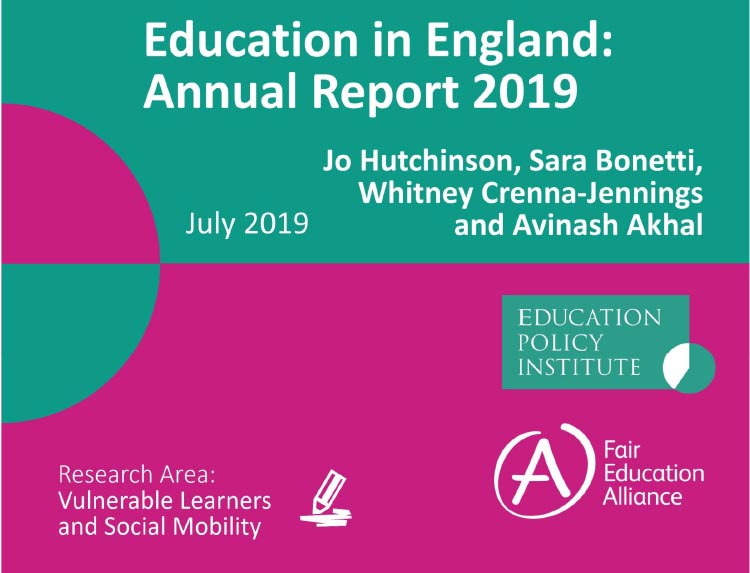Education disadvantage gap has stopped closing – Sector response

Major setback for social mobility
Today (30 Jul), the Education Policy Institute (EPI), in partnership with the Fair Education Alliance (FEA), has published its flagship Annual Report 2019 on the state of education in England.
The new report examines the progress made in closing the gap in educational attainment between disadvantaged pupils and their peers, known as ‘the disadvantage gap’.
The measure is a leading indicator of how the government is performing on social mobility.
The research, which is based on the latest Department for Education data, also considers how the gap has changed since 2011 and how it varies across the country. It also looks at how pupils from different backgrounds perform, as well as the routes taken by students after taking their GCSEs.
The report’s findings suggest that the new Prime Minister, Boris Johnson, is likely to have a considerable challenge ahead of him if he is to make meaningful progress in closing the disadvantage gap, and in his words, improve support for those parts of the country that have been “left behind”.
Key findings
The education disadvantage gap in England: The latest trends
The gap in GCSE attainment between disadvantaged pupils and non-disadvantaged pupils has stopped closing.
By the time they leave secondary school, disadvantaged pupils are now over 18.1 months behind non-disadvantaged pupils. This gap has increased slightly from last year, by 0.2 months.
In the early years (pupils in reception year), the gap has also stopped closing – having widened slightly by 0.1 months to 4.5 months.
In contrast, at primary school, the gap continues to close. By the time they leave primary school, disadvantaged pupils are now 9.2 months behind their peers – a narrowing of 0.3 months since 2017.
For the most persistently disadvantaged pupils the gap has narrowed at primary level but widened at secondary level. This means that these pupils – the very worst-off – are almost two years (22.6 months) behind all other pupils by the time they finish their GCSEs.
Despite no progress in narrowing the disadvantage gap, overall pupil attainment has continued to rise. This suggests that an overall rise in standards does not guarantee a reduction in the disadvantage gap.
How long until the GCSE disadvantage gap closes?
Over recent years, there has been a dramatic slowing down in the closure of the disadvantage gap to the extent that the five year rolling average now suggests that it would take 560 years to close the gap. However, the most recent data shows an increase in the gap in 2018 suggesting there is a real risk that we could be at a turning point and that we could soon enter a period where the gap starts to widen.
How does the disadvantage gap vary in different areas in England?
Large disadvantage gaps remain well-established in several areas in England but are particularly acute in the North. In Rotherham and Blackpool, poorer pupils are trailing their peers by over two years by the time they finish their GCSEs, on average.
London continues to dominate areas with the smallest disadvantage gaps. Poorer pupils are only 3.9 months behind their peers at GCSE in Westminster, and 5.3 months behind in Tower Hamlets.
Some areas have been highly successful at reducing levels of disadvantage in education since 2012. These include Bournemouth (reducing the GCSE gap by 6.5 months), Richmond upon Thames (5.8 months) and Waltham Forest (4.5 months).
Other areas, however, have regressed, with the gap having widened since 2012. This is especially apparent in the North West of England:in Bury, Halton and Wigan, the gap has increased by around 5 months over this period.
How are different pupil groups performing?
There are huge disparities between pupil groups, including by ethnicity. By the end of secondary school, Chinese and Indian pupils perform significantly better than their White British peers – moving ahead of them by 24.8 and 14.2 months respectively.
At the other end of the scale, Gypsy/Roma pupils are almost 3 years behind White British pupils (by 34.1 months) by the end of secondary. Travellers of Irish Heritage are 28.9 months behind, while for Black Caribbean pupils the figure is 9.3 months.
Black Caribbean pupils have experienced poor progress since 2011, having slipped a further 2.2 months behind White British pupils. In stark contrast, Pakistani pupils have made large gains on their White British peers, having been 3.4 months behind in 2011, but just 0.5 months behind in 2018.
Pupils with special educational needs remain the furthest behind: 40 months by the end of secondary school for those with greater needs. The government should consider whether it is providing adequate support to this group of pupils ahead of the upcoming Spending Review.
With the exception of Black Caribbean pupils, White and Black Caribbean pupils and White and Black African pupils, all other ethnic groups have either pulled further away from White British pupils or have caught up with them to some degree, compared to 2011.
Disadvantage after GCSEs: Post-16 education routes
The post-16 education routes taken by young people are becoming increasingly segregated by socio-economic status, with disadvantaged pupils disproportionately represented in certain routes.
In particular, the increased segregation is driven by an over-representation of disadvantaged students in further education. These trends may damage the government’s ambition of rectifying imbalances between further and higher education.
Commenting on the new research, report author Jo Hutchinson said:
“Our research shows that for the first time in several years, the gap between poorer pupils and their peers at GCSE has stopped closing. Trends suggest that this disadvantage gap may now be taking a new direction, where it begins to widen.
“In addition, we find that both black Caribbean children and persistently disadvantaged children – those eligible for free school meals for most of their school lives – are now further behind their peers than they were in 2011. There has also been no progress in closing the gap this year for children with special educational needs and disabilities.
“Rising average pupil attainment has not resulted in more equal outcomes for all, and we must be sceptical of rhetoric about social injustices that is not matched by a credible plan and resources”.
Rt. Hon. David Laws, Executive Chairman of the Education Policy Institute, said:
“We are now witnessing a major setback for social mobility in our country. Recent progress on narrowing the education gap between poor children and the rest has ground to a halt. Indeed, the very poorest children are actually further behind now than they were a decade ago – they are almost 2 years of learning on average behind other children by the time they take their GCSEs.
“Educational inequality on this scale is bad for both social mobility and economic productivity. This report should be a wake up call for our new Prime Minister. We need a renewed policy drive to narrow the disadvantage gap – and this needs to be based on evidence of what makes an impact, rather than on political ideology or guesswork.”
Cllr Anntoinette Bramble, Chair of the Local Government Association’s Children and Young People Board, said:
“Schools that stay under council control deliver better results with 89 per cent of schools having kept their good or outstanding Ofsted rating, compared to 81 per cent of schools which converted to academies.
“Councils have an excellent track record in improving schools, and need to be given the necessary powers to intervene and support all failing schools, including academies.
“Yet all this good work is at risk if all schools aren’t adequately funded, this is why it is essential that the Prime Minister provides sustainable funding during the forthcoming Spending Review, and plugs the funding gap of up to £1.6 billion by 2021 that councils face supporting children with special educational needs and disabilities (SEND).”
Rosamund McNeil, Assistant General Secretary of the National Education Union, said:
“These trends show that the Government cannot claim success for their education ‘reforms’. The new cabinet must think again on education. Cutting school funding dramatically while at the same time driving more families deeper into poverty comes at a high cost for poor and working-class students. The Government expects heads and teachers to ‘close the gap’ for disadvantaged pupils whilst ignoring United Nations evidence of how its own policies are widening the poverty gap. We shouldn’t be surprised by these findings, but they should urgently trigger a change in approach.
“The Government must commit to proactively reducing child poverty and commit to ending it. They must also provide what schools need to make education accessible – fair pay rises to retain motivated teachers, reversal of the funding cuts, and a curriculum broad and flexible enough to motivate all learners and respond to the reality of their lives. Schools can be the place where students gain a sense of optimism and agency about their futures, but we’re not giving schools what they need to make this difference. That’s simply not fair on anyone.
“The Government could do so much more to support teachers on this issue but a relentless focus on exam results and endless data is the problem and not the solution. Supporting emotional well-being and students’ sense of belonging in their school has been shown to improve students’ learning, so pressuring schools to focus on exam preparation and tests is counter-productive for both academic learning and social development. We need to focus on activities like reading for pleasure, more sport and outdoor learning and more art and drama – all are shown to engage students, close the motivation gap and inspire children’s interest and commitment to education.”
Liberal Democrats have slammed the growing inequality in our schools. This report shows that it would take over 500 years to close the gap between disadvantaged secondary school pupils and their peers at its current rate.
Commenting on these alarming findings, Liberal Democrat Education spokesperson Layla Moran said:
“Inequality is growing in the UK and in no other place is this more apparent than in our schools. The Education Policy Institute released a report today showing that it would take over 500 years, at the current rate of change, to close the gap between disadvantaged secondary school pupil and their peers.
“These shocking findings show us that the Conservative Government’s school spending cuts are failing our children. School budgets are not allowing our teachers the resources they need to give all children the opportunities to succeed in life.
“There is no better investment in this country’s future than investment in education. That is why the Liberal Democrats would devote nearly £7 billion extra to our children’s education. We will increase school budgets and the Pupil Premium to ensure that those from disadvantaged backgrounds have the same opportunities as though from the most privileged.”
Ms Chris Keates, General Secretary (Acting) of NASUWT – The Teachers’ Union, said:
“Nothing in the EPI Report comes as a surprise. It confirms what the NASUWT has been highlighting from its own research for a number of years.
“We now have an education system rife with inequality and injustice.
“Key drivers of this are Government social economic and education policies which have led to high levels of child poverty, the fragmentation of the education system, deep cuts to specialist provision vital to schools, the exploitation of the teaching workforce which has generated a national crisis in teacher supply and the rising cost of education, which for too many children now means that access to educational opportunities is based on parents’ ability to pay.
“Yet despite the wealth of evidence to support this, the Government remains in denial about the damage it has inflicted.”
School Standards Minister Nick Gibb said:
“The gap between disadvantaged pupils and their peers has narrowed considerably in both primary and secondary schools since 2011. During that time this government has delivered a range of reforms to ensure every child, regardless of their background, gets a high-quality education. We are investing £2.4 billion this year alone through the Pupil Premium to help the most disadvantaged children.
“Teachers and school leaders are helping to drive up standards right across the country, with 85% of children now in good or outstanding schools compared to just 66% in 2010, but there is more to do to continue to attract and retain talented individuals in our classrooms.”
Further information:
- The gap between disadvantaged pupils and others at key stage 2, measured using the disadvantage gap index, has decreased in each of the last seven years, narrowing by 3% in the latest year and 13.2% since 2011.
- The gap between disadvantaged pupils and others at key stage 4, measured using the disadvantage gap index has narrowed by 9.5% since 2011. In the latest year, it remained broadly stable, widening by 0.6% between 2017 and 2018.
- There is more money going into our schools than ever before and the Government has acted to tackle disadvantage by providing schools with an extra £2.4 billion this year alone through the Pupil Premium to improve disadvantaged pupils’ performance.
- New guidance available through the Education Endowment Foundation will help schools make good choices to improve their disadvantaged pupils’ outcomes.
‘The disadvantage gap’ measures the number of months of academic progress disadvantaged children are behind their non-disadvantaged peers. The disadvantage gap is examined at three education phases: early years (reception year), primary school (Key stage 2) and secondary school (Key stage 4, GCSEs).
In this report, our leading measure of the disadvantage gap at secondary school level measures attainment in GCSE English language and maths. All findings at secondary school level above relate to this measure. Examining the disadvantage gap in these two compulsory GCSE subjects gives us a more reliable assessment of the trend of the gap and a more robust basis for estimating how long it is likely to take to close, compared to the GCSE gap across all subjects. This is because English language and maths have been less affected by recent government reforms, which have affected student subject choices.
‘Disadvantaged pupils’ are defined as those pupils known to be eligible for free school meals at any point in the previous six years.
‘Persistently disadvantaged’ are those pupils who have been eligible for free school meals at least 80 per cent of their time in school.











Responses